Introduction
Failure of tooth-denture base bond is a frequent and frustrating experience to a prosthodontist. Maxillary incisors and canines separate most frequently from the denture base. Several factors related to material composition and laboratory procedures affect the bonding.
Attempts to improve bond strength have involved chemical treatment or mechanical modification of the ridge lap surface. Cardash et al (1990) found both an increase[1] and decrease[2] in bond strength with mechanical modification of ridge lap. This requires further investigation.
So, this study was done to determine the effect of retention grooves (horizontal and vertical) of various shapes on tooth-denture base bond strength.
Methods
The study was conducted on 180 acrylic resin teeth of the same mold (Rolex crosslinked)-Maxillary Central Incisors (60), Lateral Incisors (60) and Canines (60). The denture base material used was Heat cure acrylic resin (DPI Heat Cure Denture Base Material)
Teeth Preparation
Glossy ridge lap surface of all the teeth was ground and divided into groups, each group having 12 Central Incisors, 12 Lateral Incisors, and 12 Canines.
In
Group A : No tooth preparation was done.
Group B : Mesiodistal groove 2mm deep and 2mm wide was cut into the ridge lap surface of all teeth with a straight fissure bur.
Group C : Mesiodistal groove of similar dimensions was made with an inverted cone bur.
Group D : Vertical groove of the same dimensions was cut into the centre of the ridge lap surface extending halfway up the lingual surface of teeth with a straight fissure bur.
Group E : Vertical groove of similar dimensions was made with an inverted cone bur. (Fig 1, Fig 2)
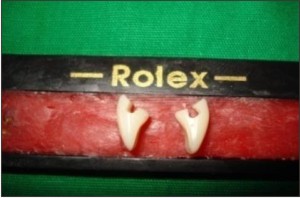 | Fig - 1
 |
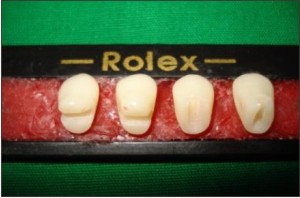 | Fig - 2
 |
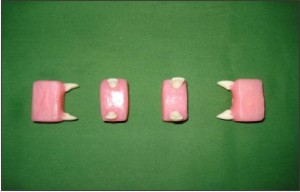 | Test Specimens
 |
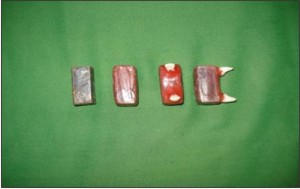 | Wax Molds
 |
 | Fig - 3
 |
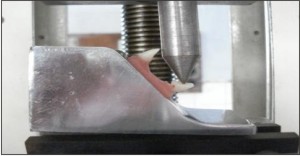 | Fig - 4
 |
To prevent slipping of the testing apparatus, a hole (1mm diameter) was drilled 3mm from the incisal edge on the palatal surface of each tooth, measuring the distance using divider and scale.
Preparation of the test specimens
Modelling wax was adapted on all the sides of custom made rectangular shaped master metallic blocks to form molds for mounting the teeth . Two teeth, one on each side of the mold were mounted, keeping the long axis of each tooth perpendicular to themold
These molds were flasked in metallic flasks, wax boiled out and the flasks allowed to cool.Cold mould seal was applied taking care not to contaminate the ridge lap surface of teeth. Heat cure acrylic resin was mixed, packed into the flasks and the specimens cured.
 | Bar Diagram Showing Means Of Bond Strengths
 |
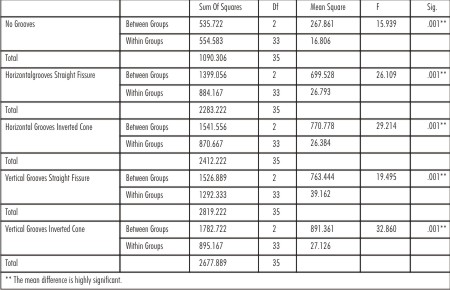 | ANOVA TREATMENT
 |
The specimens were deflasked, and cleaned. Ninety such specimens were prepared. Extra acrylic enveloping the necks of teeth was removed so that only the ridge lap base of the tooth was in contact with the denture base resin.
Testing Procedure
The acrylic resin blocks with teeth were secured in a custom made stainless steel metal jig. The jig was so designed that when load was applied on palatal surface of each tooth, its direction was at an angle of 1300 to the long axis of tooth. (Fig 3)
The whole assembly was made to fit in the digital Universal Testing Machine and a load with 1mm tip diameter applied on the palatal surface of teeth, 3mm from its incisal edge at a crosshead speed of 5mm/minute until fracture occurred (Fig 4)
Results
The force applied for each tooth was noted and tabulated (Tables 1-3). The data was analyzed statistically by ANOVA and Post Hoc Tests (Tables 4-6). The results demonstrated that shear compressive bond strength of specimens prepared with vertical retention grooves (inverted cone) was greater (31.94 + 8.75 kg) than that of vertical grooves (straight fissure) (30.28 + 8.98 kg), horizontal grooves (inverted cone) (23.22 + 8.30 kg) and horizontal grooves (straight fissure) (21.72 + 8.08 kg). The control group (specimens with no grooves) demonstrated the least bond strength (13.36 + 5.58 kg).
As regards the types of teeth, canines exhibited the maximum and lateral incisors the least bond strength within all groups. However, the difference in bond strengths between central incisors and canines was found to be statistically insignificant (p>0.05).
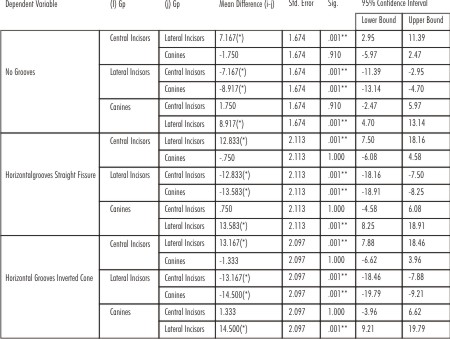 | POST HOC TESTS
 |
Discussion
Acrylic resin (poly methyl methacrylate) has been the most commonly employed material in denture construction. Despite its popularity, there has been an unresolved problem of denture fracture and tooth denture base faiure. Several retention systems for denture teeth have been proposed in the literature e.g. macromechanical (pins and diatoric undercuts), micromechanical (high energy abrasion), or chemical adhesion methods (silanization).
The present study evaluated the effect of retention grooves on shear compressive bond strength of acrylic resin teeth to heat-cure denture-base resin.An attempt was made to simulate the forces applied to maxillary denture teeth in the clinical situation by applying a shear compressive force to the palatal surface of teeth at an angle of 1300 to the long axis of the teeth.
It was noted that mechanical preparation of teeth with different types of grooves increased the tooth-denture base bond strength. These results were consistent with the studies done by Cardash[1] et al (1990), Huggett[3] et al (1982), Barpal[4] et al (1998), Fletcher[5] et al (1985), Vallitu[6] (1995), Chung[7] et al (1995), Caswell and Norling[8] (1986).
The increased bond strength can be ascribed to the increased the surface area and mechanical interlocking across the tooth-denture base interface because of the retention grooves. This could also be due to an enhanced surface reactivity as a result of removal of a saturated surface layer by grinding and the exposure of the subsurface layer of a higher free surface energy exhibiting better wettability by the monomer, enhancing the bond strength.
As far as the types of grooves are concerned, the vertical grooves (prepared with inverted cone bur) exhibited the highest bond strength. This is in accordance with the study conducted by Cardash[1] et al. They reported a 44% increase in bond resistance to shear stresses by cutting vertical grooves in the ridge lap. This could be due to the fact that the vertical groove was closer to the point of application of the force, presenting with a shorter lever arm which required greater force to separate the tooth from the denture base resin.
Teeth with grooves prepared with inverted cone bur exhibited significantly higher (p<0.05) bond strength than those prepared with straight fissure bur, probably because of the increased mechanical interlocking produced by the shape of the groove.
Within all groups, canines demonstrated the maximum bond strength. However, the difference between the bond strengths of the centrals and the canines was not statistically significant (p>0.05). These results were consistent with those of Huggett[3] et al. and Cardash[1] et al. The lesser bond strength of lateral incisors could probably be due to considerably lesser surface for bonding to the denture base acrylic resin.
In contrast to these results, Cardash[2] et al derived no statistically significant advantage by preparing retention grooves in the ridge lap surface of denture teeth. According to Cunningham and Beningtom[9], tooth surface modification made no significant difference in bond strength when compared with unmodified surfaces. Spartley[10] in an earlier study, reported a 40% reduction in bond strength by roughening the tooth ridge laps. Differences in the type of denture teeth, denture base acrylic resin and experimental techniques may have contributed to the variability of the reported results.
Although this in-vitro study evaluated the effect of retention grooves on tooth-denture base bond strength, it did not simulate the clinical conditions ideally, as the dentures are exposed to functional and parafunctional forces in warm and wet oral conditions. Also, the use of a simple rectangular shaped specimen rather than a complex denture design contributes further to the limitations of the present study.
Within the limitations of this study, more research is indicated to evaluate the tooth-denture base bond strength in more closely simulated clinical conditions.
Conclusions
Teeth with retention grooves exhibited significantly higher bond strength than the control group .
Teeth with vertical grooves (inverted cone bur) demonstrated the maximum bond strength.
Within all groups, Canines exhibited the maximum and Lateral incisors the least bond strength. However, the difference between central incisors and canines was statistically insignificant (p>0.05).
References
1. Cardash et al. Effect of retention grooves on tooth-denture base bond. J Prosthet Dent 1990;64:492-96.
2. Cardash et al. Effect of retention grooves in acrylic resin teeth on tooth-denture base bond. J Prosthet Dent 1986;55:526-28.
3. Huggett. et al. Strength of acrylic denture base tooth bond. B. Dent Journal 1982;153:187-90.
4. Barpal et al. Failure load of acrylic resin denture teeth bonded to high impact acrylic resins. J Prosthet Dent 1998;80:666-71
5. Fletcher et al. A method of improving the bonding between artificial teeth and PMMA. . J Dent 1985;13(2):102-08.
6. Vallitu P.K. Bonding of resin teeth to the polymethyl methacrylate denture base material.Acta Odontol Scand 1995;55:99-104.
7. Chung et al. The bonding of cold-curing acrylic resin to acrylic denture teeth. Aust Dent J 1995;40(4):241-5.
8. Caswell and Norling. Comparative study of the bond strengths of three abrasion -resistant plastic denture teeth bonded to a cross-linked and a grafted, cross-linked denture base material. J Prosthet Dent 1986;55:701-08.
9. Cunningham J.L. and Benington.I.C. An investigation of the variables which may affect the bond between plastic teeth and denture base resin. J Dent 1999;27:129-135.
10. Spartley M.H. An investigation of the adhesion of acrylic resin teeth to dentures. J Prosthet Dent 1997;58:389-92.
11. Darbar U.R., Huggett R. and Harrison A. Denture fracture- A survey. B.Dent Journal 1994,176:342-345.
12. Catterlin et al. Effect of tinfoil substitute contamination on adhesion of resin denture tooth to its denture base. J Prosthet Dent 1993;69:57-59.
13. Saavedra et al. Bond strength of acrylic teeth to denture base resin after various surface conditioning methods before and after thermocycling. Int J Prosthodont 2007;20:199-201.
14. Darbar et al. Finite element analysis of stress distribution at the tooth-denture base interface of acrylic resin teeth debonding from the denture base. J Prosthet Dent 1995;74:591-4.
15. Morrow et al. Bonding of plastic teeth to two heat-curing denture base resins. . J Prosthet Dent 1978;39:565-68. |